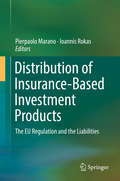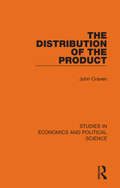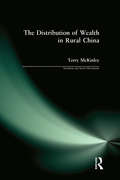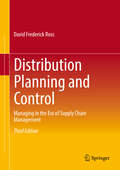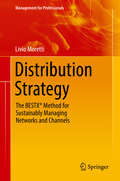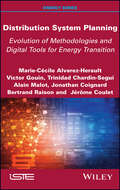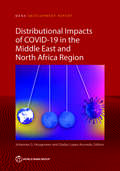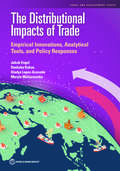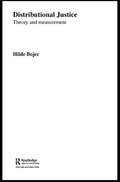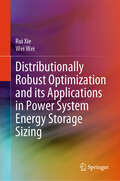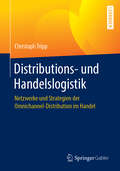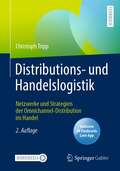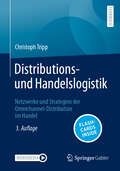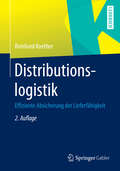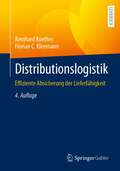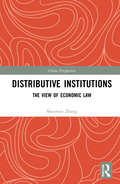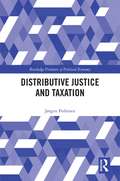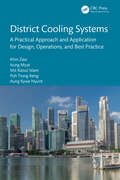- Table View
- List View
Distribution of Insurance-Based Investment Products: The EU Regulation and the Liabilities
by Pierpaolo Marano Ioannis RokasThe book addresses a topic at the intersection of two heavily regulated sectors: insurance and investment services. Until recently, scholars and professionals have approached insurance and investment services as two separate categories in the financial services sector, and as being governed by separate regulatory frameworks. In practice, however, the boundaries were and are blurred, a reality that regulators have begun to recognize and address in their more recent regulatory texts. The first part of the book approaches the new standards applicable to investment products based on insurance: insurance-based investment products (IBIPs). These rules are harmonized across the EU. The rationale behind this new definition is provided, together with a description of these products’ limitations. The analysis addresses the new rules and explores the legal regime and relevant standards applicable to IBIPs. The organizational rules concerning the design and distribution of IBIPs are also examined, and the book highlights e.g. how these rules are inspired by the principles of conduct. In closing, the ADR systems are analysed, in order to ascertain whether or not they can offer an effective tool for settling disputes over these products. In turn, the second part focuses on the liability for distribution of IBIPs, which ranks as one of the most conspicuous and relatively new legal phenomena, but at the same time, represents an exceptionally important field of civil liability in today’s world. Liability is still regulated at the national level. Thus, the four largest life insurance markets in the EU are considered, along with the largest emerging market for life insurance. The chapters on national laws also consider whether, and if so, how the new harmonized rules on IBIPs are being combined with those already in force in the jurisdictions considered. The goal is to determine whether the new rules are likely to change the doctrine and case law approach to these products, or whether the European legislators’ choices have no real impact on the protection of clients.
The Distribution of the Product (Studies in Economics and Political Science)
by John CravenOriginally published in 1979, the purpose of this book is to introduce a theory of the distribution of national income between wages, profits and other categories of income. The relation between this branch of distribution theory and other areas of economics is explained in the Introduction. The first six chapters are designed to introduce distribution theory to students of intermediate economic principles. The reader should be familiar with the basic analysis of supply, demand and market equilibrium, and with the use of indifference curves to represent a consumer’s preferences. The remaining seven chapters discuss developments of the theory introduced in the first six.
The Distribution of Wealth in Rural China (Socialism And Social Movements Ser.)
by Terry McKinleyBased on an analysis of a 1988 nationwide sample survey of 10,258 households, this book aims to offer insights into issues of rural inequality in China. The work focuses on the study of wealth rather than income as the primary measure.
Distribution Planning and Control: Managing In The Era Of Supply Chain Management (Chapman And Hall Materials Management/logistics Ser.)
by David Frederick RossThis third edition provides operations management students, academics and professionals with a fully up-to-date, practical and comprehensive sourcebook in the science of distribution and Supply Chain Management (SCM). Its objective is not only to discover the roots and detail the techniques of supply and delivery channel networks, but also to explore the impact of the merger of SCM concepts and information technologies on all aspects of internal business and supply channel management. This textbook provides a thorough and sometimes analytical view of the topic, while remaining approachable from the standpoint of the reader. Although the text is broad enough to encompass all the management activities found in today's logistics and distribution channel organizations, it is detailed enough to provide the reader with a thorough understanding of essential strategic and tactical planning and control processes, as well as problem-solving techniques that can be applied to everyday operations. Distribution Planning and Control: Managing in the Era of Supply Chain Management, 3rd Ed. is comprised of fifteen chapters, divided into five units. Unit 1 of the text, The SCM and Distribution Management Environment, sets the background necessary to understand today's supply chain environment. Unit 2, SCM Strategies, Channel Structures and Demand Management, reviews the activities involved in performing strategic planning, designing channel networks, forecasting and managing channel demand. Unit 3, Inventory Management in the Supply Chain Environment, provides an in-depth review of managing supply chain inventories, statistical inventory management, and inventory management in a multiechelon channel environment. Unit 4, Supply Chain Execution, traces the translation of the strategic supply chain plans into detailed customer and supplier management, warehousing and transportation operations activities. Finally Unit 5, International Distribution and Supply Chain Technologies, concludes the text by exploring the role of two integral elements of SCM: international distribution management and the deployment of information technologies in the supply chain environment. Each chapter includes summary questions and problems to challenge readers to their knowledge of concepts and topics covered. Additionally supplementary materials for instructors are also available as tools for learning reinforcement.
Distribution Policy
by Robert J. DolanPresents some fundamental principles of channels of distribution management.
Distribution Strategy: The Bestx® Method For Managing Networks And Channels Sustainably (Management for Professionals)
by Livio Moretti"Every good business manager needs to have a microscope on one eye and a telescope on the other eye – this practical, easy to follow book, anchored in solid analytic principles, allows for fast and solid transitions between diagnosis, long-term strategic thinking, and short-term execution." Bruno Barcelos, General Manager Sandoz, a Novartis Company
Distribution System Planning: Evolution of Methodologies and Digital Tools for Energy Transition
by Marie-Cecile Alvarez-Herault Victor Gouin Trinidad Chardin-Segui Alain Malot Jonathan Coignard Bertrand Raison Jerome CouletDistribution systems drive energy and societal transition. System planning enables investments to be made in the right place, at the right time and with the right technology. Distribution System Planning is centered on the evolution of planning methods that will best support this transition, and describes the historical context and concepts that enable planning, its challenges and key influencing factors to be grasped. It also analyzes the impact of the development of renewable and decentralized energy resources, government recommendations and distributor initiatives to promote their integration. Through the use of case studies, this book provides examples of how planning methodologies have evolved, as well as an overview of new and emerging solutions.
Distributional Effects of Environmental and Energy Policy (The International Library of Environmental Economics and Policy)
by Don FullertonMany effects of environmental and energy policy are likely to disproportionately burden those with low income. First, it raises the price of fossil-fuel-intensive products that constitute a high fraction of low-income budgets (like gasoline, heating fuel and electricity). Second, the handout of pollution permits to firms provides value to those who own them. Third, low-income individuals may place more value on food and shelter than on improvements in environmental quality, so high-income individuals may get the most benefit of pollution abatement. Fourth, air quality improvements may raise the value of houses owned by landlords, rather than helping renters. These effects might all hurt the poor more than the rich. This book brings together the seminal economics literature that studies whether these fears are valid and whether anything can be done about them.
The Distributional Impact of Fiscal Policy in Honduras
by Robert Gillingham David Newhouse Irene YackovlevA report from the International Monetary Fund.
Distributional Impacts of COVID-19 in the Middle East and North Africa Region (MENA Development Report)
by Johannes G. Hoogeveen and Gladys Lopez-AcevedoCOVID-19 is one of multiple crises to have hit the Middle East and North Africa (MENA) region in the decade following the Arab Spring. War, oil price declines, economic slowdowns, and now a pandemic are tearing at the social fabric of a region characterized by high rates of unemployment, high levels of informality, and low annual economic growth. The economic costs of the pandemic are estimated at about US$227 billion, and fiscal support packages across MENA are averaging 2.7 percent of GDP, putting pressure on already weak fiscal balances and making a quick recovery challenging. Even before the COVID-19 pandemic, MENA was the only region in the world experiencing increases in poverty and declines in life satisfaction. Distributional Impacts of COVID-19 in the Middle East and North Africa Region investigates how COVID-19 changed the welfare of individuals and households in the region. It does so by relying on phone surveys implemented across the region and complements these with microsimulation exercises to assess the impact of COVID-19 on jobs, income, poverty, and inequality. The two approaches complement and corroborate each other's results, thereby making the findings more robust and richer. This report's results show that, in the short run, poverty rates in MENA will increase significantly and inequality will widen. A group of 'new poor' is likely to emerge that may have difficulty recovering from the economic consequences of COVID-19. The report adds value by analyzing newly gathered primary data, along with projections based on newly modeled micro- and macrosimulations, and by identifying key issues that policy makers should focus on to enable a quick, inclusive, and sustained economic recovery.
The Distributional Impacts of Trade: Empirical Innovations, Analytical Tools, and Policy Responses (Trade and Development)
by Jakob Engel Deeksha Kokas Gladys Lopez-Acevedo MaliszewskaTrade is a well-established driver of growth and poverty reduction.But changes in trade policy also have distributional impacts that create winners and losers. It is vital to understand and clearly communicate how trade affects economic well-being across all segments of the population, as well as how policies can more effectively ensure that the gains from trade are distributed more widely. The Distributional Impacts of Trade: Empirical Innovations, Analytical Tools, and Policy Responses provides a deeper understanding of the distributional effects of trade across regions, industries, and demographic groups within countries over time. It includes an overview (chapter 1); a review of innovations in empirical and theoretical work covering the impacts of trade at the subnational level (chapter 2); highlights from empirical case studies on Bangladesh, Brazil, Mexico, South Africa, and Sri Lanka (chapter 3); and a policy agenda to improve distributional outcomes from trade (chapter 4). This book comes at a time when the shock from COVID-19 (coronavirus) adds to an already uncertain trade policy environment in which the value of the multilateral trading system has been under increased scrutiny. A better understanding of how trade affects distributional outcomes can lead to more inclusive policies and support the ability of countries to maximize broad-based benefits from trade.
Distributional Justice: Theory and Measurement (Routledge Frontiers of Political Economy #Vol. 47)
by Hilde BojerIntroducing the main theories of distributional justice the book covers utilitarianism and welfare economics, moving on to Rawls's social contract and the Sen/Nussbaum capability approach with a refreshingly readable style. There is a chapter covering the position of mothers and children in theories of justice. The book then studies empirical methods used in analysing the distribution of economic goods, covering Lorenz curves and inequality measures. The concepts of income, wealth and economic goods are comprehensively discussed, with a particular view to their role in theories of justice. This book is an important read for economists and other social scientists, as well as philosophers who want to quantify social and economic justice.
Distributionally Robust Optimization and its Applications in Power System Energy Storage Sizing
by Wei Wei Rui XieThis book introduces the mathematical foundations of distributionally robust optimization (DRO) for decision-making problems with ambiguous uncertainties and applies them to tackle the critical challenge of energy storage sizing in renewable-integrated power systems, providing readers with an efficient and reliable approach to analyze and design real-world energy systems with uncertainties. Covering a diverse range of topics, this book starts by exploring the necessity for energy storage in evolving power systems and examining the benefits of employing distributionally robust optimization. Subsequently, the cutting-edge mathematical theory of distributionally robust optimization is presented, including both the general theory and moment-based, KL-divergence, and Wasserstein-metric distributionally robust optimization theories. The techniques are then applied to various practical energy storage sizing scenarios, such as stand-alone microgrids, large-scale renewable power plants, bulk power grids, and multi-carrier energy networks. This book offers clear explanations and accessible guidance to bridge the gap between advanced optimization methods and industrial applications. Its interdisciplinary scope makes the book appealing to researchers, graduate students, and industry professionals working in electrical engineering and operations research, catering to both beginners and experts.
Distributions- und Handelslogistik: Netzwerke Und Strategien Der Omnichannel-distribution Im Handel
by Christoph TrippDieses Buch zeigt die wichtige Rolle der Distributions- und Handelslogistik vor dem Hintergrund des zunehmenden Einflusses der Digitalisierung auf Prozesse, Strukturen und Systeme in den logistischen Netzwerken der Konsumgüterwirtschaft. Durch die besondere Transportintensität, die Lagerkomplexität und erhebliche Flexibilitätsanforderungen in der Auftragsabwicklung entstehen hohe Logistikkosten. Andererseits steigen die Serviceanforderungen der Kunden durch den wachsenden Onlinehandel. Für Händler ergibt sich in der Distributionslogistik ein Zielkonflikt aus notwendigen Kostenoptimierungen und kundenseitig erwarteten Serviceerweiterungen. Anhand von zahlreichen Praxisbeispielen wird anschaulich beschrieben, wie sich die Distributionssysteme von Unternehmen verändern müssen, um den Anforderungen des Multi- bzw. Omnichannel-Handels gerecht werden zu können. Lernziele und Kontrollfragen zu jedem Kapitel ergänzen die Ausführungen und ermöglichen eine optimale Prüfungsvorbereitung.
Distributions- und Handelslogistik: Netzwerke und Strategien der Omnichannel-Distribution im Handel
by Christoph TrippDieses Buch zeigt die wichtige Rolle und Systemrelevanz der Distributions- und Handelslogistik vor dem Hintergrund des zunehmenden Einflusses der Digitalisierung und der Nachhaltigkeit auf Prozesse, Strukturen und Systeme in den logistischen Netzwerken der Konsumgüterwirtschaft. Durch die besondere Transportintensität, die Lagerkomplexität und erhebliche Flexibilitätsanforderungen in der Auftragsabwicklung entstehen hohe Logistikkosten. Andererseits steigen die Serviceanforderungen der Kunden durch den wachsenden Onlinehandel. Für Händler ergibt sich in der Distributionslogistik ein Zielkonflikt aus notwendigen Kostenoptimierungen und kundenseitig erwarteten Serviceerweiterungen.Anhand von zahlreichen Praxisbeispielen wird anschaulich beschrieben, wie sich die Distributionssysteme von Unternehmen verändern müssen, um den Anforderungen des Omnichannel-Handels gerecht werden zu können. Lernziele und Kontrollfragen zu jedem Kapitel ergänzen die Ausführungen und ermöglichen eine optimale Prüfungsvorbereitung.In der 2. Auflage wurden umfangreiche Aktualisierungen und Überarbeitungen vorgenommen sowie zusätzliche Praxisbeispiele ergänzt. In Konsequenz der globalen Ereignisse in den vergangenen Jahren nehmen Technologien, Convenience-Erwartungen, Adaptivitäts- und Resilienzanforderungen sowie ökologische und soziale Nachhaltigkeit eine noch stärkere Rolle im Rahmen dieser Auflage ein.Zusatznutzen: Laden Sie die Springer Nature Flashcards-App mit insgesamt 220 Fragen kostenlos herunter und überprüfen Sie Ihr Wissen.
Distributions- und Handelslogistik: Netzwerke und Strategien der Omnichannel-Distribution im Handel
by Christoph TrippDieses Buch zeigt die wichtige Rolle und Systemrelevanz der Distributions- und Handelslogistik vor dem Hintergrund des zunehmenden Einflusses von Convenience, Digitalisierung, Nachhaltigkeit und Resilienz auf Prozesse, Strukturen und Systeme in den Logistiknetzwerken des Handels. Daraus ergibt sich ein immer herausfordernder Zielkonflikt aus notwendigen Kostenoptimierungen und kundenseitig erwarteten Serviceerweiterungen. Mit der dritten Auflage liegt eine völlig überarbeitete und erweiterte Ausgabe des Buches vor, die 125 Abbildungen, 22 Tabellen sowie hunderte Praxis- und Fallbeispiele enthält. Sie trägt vor allem den sich wandelnden globalen Geschäftsmodellen im Handel Rechnung, indem ein stärkerer Fokus auf internationale Beispiele, vor allem aus den USA und China, gelegt wird. Zudem bedingen die zunehmende Vermischung von Einzel- und Großhandelskonzepten und die hohe Relevanz des Onlinehandels sowie des Lieferservices in Großhandelsunternehmen eine verstärkte Berücksichtigung von Beispielen aus dem B2B-Handel. Zusatznutzen: Laden Sie die Springer Nature Flashcards-App mit insgesamt 222 Fragen und Antworten kostenlos herunter und überprüfen Sie Ihr Wissen.
Distributionslogistik: Effiziente Absicherung der Lieferfähigkeit
by Reinhard KoetherDieses Buch beschreibt anschaulich die verschiedenen Aspekte der Distributionslogistik und zeigt anhand zahlreicher Beispiele leistungsfähiger Distributionslogistik, wie Unternehmen den vorgestellten Methodenbaukasten als Wettbewerbsvorteil nutzen können. Nur wer liefern kann, macht das Geschäft. Diese alte Kaufmannsregel ist die Kernaufgabe der Distributionslogistik: Sicherzustellen, dass die Kunden die bestellten Waren rechtzeitig, sicher und in guter Qualität erhalten. Der Verkäufer muss darauf achten, dass auch die Bestands- und Transportkosten stimmen. Mit der Leistungsfähigkeit moderner Distributionslogistik werden die Kunden anspruchsvoller, d. h. alle Produkte sollen in der gewünschten Form überall, schnell und preisgünstig verfügbar sein.
Distributionslogistik: Effiziente Absicherung der Lieferfähigkeit
by Reinhard KoetherNur wer liefern kann, macht das Geschäft. Diese alte Kaufmannsregel ist die Kernaufgabe der Distributionslogistik: Sicherzustellen, dass die Kunden die bestellten Waren rechtzeitig, sicher und in guter Qualität erhalten. Der Verkäufer muss darauf achten, dass auch die Bestands- und Transportkosten stimmen. Mit der Leistungsfähigkeit moderner Distributionslogistik werden die Kunden anspruchsvoller, d. h. alle Produkte sollen in der gewünschten Form überall, schnell und preisgünstig verfügbar sein. Dieses Buch beschreibt anschaulich die verschiedenen Aspekte der Distributionslogistik und zeigt anhand zahlreicher Beispiele leistungsfähiger Distributionslogistik, wie Unternehmen den vorgestellten Methodenbaukasten als Wettbewerbsvorteil nutzen können.
Distributionslogistik: Effiziente Absicherung der Lieferfähigkeit
by Reinhard Koether Florian C. KleemannDieses Buch beschreibt anschaulich die verschiedenen Aspekte der Distributionslogistik und zeigt anhand zahlreicher Beispiele leistungsfähiger Distributionslogistik, wie Unternehmen den vorgestellten Methodenbaukasten als Wettbewerbsvorteil nutzen können. Nur wer liefern kann, macht das Geschäft. Diese alte Kaufmannsregel ist die Kernaufgabe der Distributionslogistik: Sicherzustellen, dass die Kunden die bestellten Waren rechtzeitig, sicher und in guter Qualität erhalten. Der Verkäufer muss darauf achten, dass auch die Bestands- und Transportkosten stimmen. Mit der Leistungsfähigkeit moderner Distributionslogistik werden die Kunden anspruchsvoller, d. h. alle Produkte sollen in der gewünschten Form überall, schnell und preisgünstig verfügbar sein. In der 4. Auflage wurden die Inhalte und Daten überarbeitet und an die aktuellen Entwicklungen angepasst.
Distributive Institutions: The View of Economic Law (China Perspectives)
by Shouwen ZhangThe crisis of distribution is one of the longest standing and most complicated issues facing human society. Imbued with social, political, historic, and cultural elements, it varies significantly across different countries as a result of all these factors. As an emerging economy which transferred from a planned to a market economy, China has experienced large distribution gaps since it implemented the Reform and Opening-up Policy in the early 1980s, requiring stronger economic law to mitigate and regulate the crisis of distribution. In this second volume, the author analyses crises of distribution from a theoretical perspective and proposes law and policy solutions. Believing that such crises are a collective result of systematic limitations, the author proposes a theoretical framework of “system–distribution–development” in order to resolve distribution problems and promote economic development. He argues that a crisis of distribution cannot be avoided without coordinated development of economic law and relevant constitutional, civil, and commercial law systems. In addition, it is necessary to differentiate the territories, industries, enterprises, and individuals that constitute such diverse systems. The book should be of keen interest to researchers and students of law, economics, and political science.
Distributive Justice
by Michael AllinghamThis book presents a critical appraisal of the main theories of distributive justice. It develops the view that all such theories, or at least all liberal theories, may be seen as expressions of laissez-faire with compensations for factors that they consider to be morally arbitrary. More precisely, these theories are interpreted as specifying that the outcome of individuals acting independently, without the intervention of any central authority, is just, provided that those who fare ill for reasons that the theories deem to be arbitrary, for example, because they have fewer talents than others, receive compensation from those who fare well. The principal theories discussed are Rawls’s justice as fairness, Dworkin’s equality of resources, what may loosely be called Steiner-Vallentyne common ownership theories, and Nozick’s entitlements theory. The book considers the extent, if any, to which the theories examined can accommodate both liberty and equality. It concludes that if any such accommodation is possible it will be found in common ownership theories.
Distributive Justice and Taxation (Routledge Frontiers of Political Economy)
by Jørgen PedersenProviding a thorough examination of distributive justice, Distributive Justice and Taxation presents and discusses different theories of what constitutes a just society, and how goods should be distributed in such a society. The distribution of goods in society has direct and serious consequences on the lives of the people. There are therefore important questions to be asked regarding the justice of that distribution: Is it just that some people inherit large fortunes while others inherit nothing? Do rich people have additional access to political power because of their wealth? If so, is that just? And should the ambition for economic policies be to combat poverty, or to reduce inequality? This book explores these questions and a number of others through the analysis of related theories, spanning from strong egalitarian theories on the left to right-wing libertarianism. The chapters also explicitly examine the case of taxation – one of the most important and controversial measures of distribution of goods in society. Placing emphasis on the case of Norway and using data from both the UK and USA as a point of comparison, the work details and explores the key features of the tax system. It concludes by presenting and evaluating arguments for and against taxes such as income tax, wealth tax, and inheritance tax. This book is essential reading for those interested in distributive justice, as well as students and scholars of philosophy, law, political science, and economics.
District Cooling: Theory and Practice (Heat Transfer #7)
by Alaa A. OlamaDISTRICT COOLING: THEORY and PRACTICE provides a unique study of an energy cogeneration system, set up to bring chilled water to buildings (offices, apartment houses, and factories) needing cooling for air conditioning and refrigeration. In winter, the source for the cooling can often be sea water, so it is a cheaper resource than using electricity to run compressors for cooling. The related technology of District Heating has been an established engineering practice for many years, but District Cooling is a relatively new technology now being implemented in various parts of the world, including the USA, Arab Emirates and Kuwait, and Saudi Arabia. Existing books in the area are scarce, and do not address many of the crucial issues facing nations with high overall air temperatures, many of which are developing District Cooling plans using sea water. DISTRICT COOLING: THEORY & PRACTICE integrates the theory behind district cooling planning with the practical engineering approaches, so it can serve the policy makers, engineers, and planners whose efforts have to be coordinated and closely managed to make such systems effective and affordable. In times of rising worldwide temperatures, District Cooling is a way to provide needed cooling with energy conservation and sustainability. This book will be the most up-to-date and comprehensive study on the subject, with Case Studies describing real projects in detail.
District Cooling Systems: A Practical Approach and Application for Design, Operations, and Best Practice
by Khin Zaw Aung Myat Md Raisul Islam Poh Tiong Keng Aung Kywe NyuntThis book draws on the authors’ industry and academic expertise to explain the theory and practice of district cooling systems (DCS). The in-depth exploration of the design and development of DCS presents detailed best practices for their optimization in both the development and operation phases.Readers will gain in-depth practical knowledge on all areas and considerations related to DCS technology's best practices, including current practical research areas and future potential research areas. This book addresses five areas related to DCS: the fundamentals of DCS technology, design optimization for development purposes, real-time optimization for daily operations, techno-commercial decision-making framework, and industry best practice. This information is presented through analyses of technological progress to date; case studies of current operations; and in-depth discussions of the theoretical bases and commercial, technical, and environmental benefits. Through this book, readers can recognize and apply best practices for the design, development, and operation of an optimal DCS design based on multiple factors including financial analysis, energy efficiency considerations, and practical operation issues. This will enable them to contribute to national and international sustainable development goals regarding sustainable cities and climate action.As this book provides both industry know-how and future research directions related to DCS, it is invaluable for DCS industry professionals and advanced undergraduate and postgraduate engineering students who aim to enter this industry and develop leading, highly efficient DCS systems. Overall, it is a vital resource for anyone involved in the planning, execution, and management of DCS projects.
The Districts: Stories of American Justice from the Federal Courts
by Johnny DwyerAn unprecedented plunge into New York City's federal court system that gives us a revelatory picture of how our justice system, and the pursuit of justice, really works.A young Italian Mafioso helps get rid of a body in Queens. In Manhattan, a hedge fund portfolio manager misrepresents his company's assets to investors. At JFK International Airport, a college student returns from Jamaica with cocaine stuffed in the handle of her suitcase. These are just a few of the stories that come to life in this comprehensive look at the Southern District Court in Manhattan, and the Eastern District Court in Brooklyn--the two federal courts tasked with maintaining order in New York City. Johnny Dwyer takes us not just into the courtrooms but into the lives of those who enter through its doors: the judges and attorneys, prosecutors and defendants, winners and losers. He examines crimes we've read about in the papers or seen in movies and on television--organized crime, terrorism, drug trafficking, corruption, and white-collar crime--and weaves in the nuances that rarely make it into headlines. Brimming with detail and drama, The Districts illuminates the meaning of intent, of reasonable doubt, of deception, and--perhaps most important of all--of justice.
